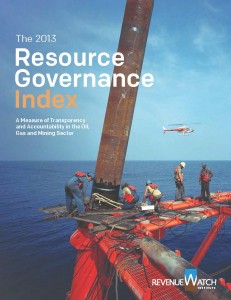The Revenue Watch 2013 Resource Governance Index
By Revenue Watch Institute • May 18, 2013Introduction
 The Resource Governance Index (RGI) measures the quality of governance in the oil, gas and mining sector of 58 countries. From highly ranked countries like Norway, the United Kingdom and Brazil to lowranking countries like Qatar, Turkmenistan and Myanmar, the Index identifies critical achievements and challenges in natural resource governance.
The Resource Governance Index (RGI) measures the quality of governance in the oil, gas and mining sector of 58 countries. From highly ranked countries like Norway, the United Kingdom and Brazil to lowranking countries like Qatar, Turkmenistan and Myanmar, the Index identifies critical achievements and challenges in natural resource governance.
The 58 countries produce 85 percent of the world’s petroleum, 90 percent of diamonds and 80 percent of copper. Profits from their extractive sector totaled more than $2.6 trillion in 2010. In 41 of these countries, the extractive sector contributed a third of gross domestic product and half of total exports on average. Revenues from natural resources dwarf international aid: In 2011, oil revenues for Nigeria alone were 60 percent higher than total international aid to all of sub-Saharan Africa. The future of these countries depends on how well they manage their oil, gas and minerals.
Mismanagement and corruption have many manifestations and can have dire consequences. Some countries negotiate poor terms with extractive companies, forsaking potential long-term benefits. Many countries do not collect resource revenues effectively. And even when resource revenues do end up in government coffers, they aren’t always spent in ways that benefit the public. Too often, governments keep citizens and civil society leaders in the dark regarding government contracts and resource revenues. This opacity deprives the public of a voice or even representation in basic decisions on natural resources.
The RGI is based on the premise that good governance of natural resources is necessary for the successful development of countries with abundant oil, gas and minerals. It provides a diagnostic tool to help identify good practices as well as governance shortcomings.
The RGI evaluates four key components of resource governance in each country: Institutional and Legal Setting; Reporting Practices; Safeguards and Quality Controls; and Enabling Environment. The Index (See Figure 1) assigns a numerical score to each country and divides them into four performance ranges—satisfactory (71-100, marked in green), partial (51-70, yellow), weak (41-50, orange) and failing (0-40, red).
Download the full report here.
Tags: Myanmar Oil and Gas Enterprise, Natural Resources, Resource Governance Index, Revenue Watch Institute, Shwe Gas ProjectThis post is in: Business and Human Rights, Environmental and Economic Justice
Related PostsNorthern Shan Farmers Call for Chinese Pipelines to be Removed from their Lands
Burma: US Backtracks on ‘Responsible Investment’ Pledge
Statement on Foreign Investment in Burma









 All posts
All posts